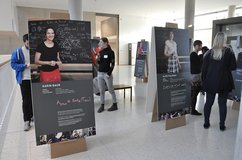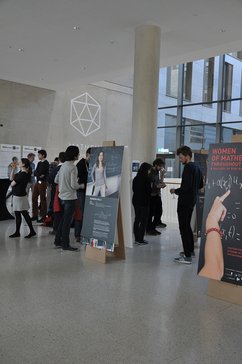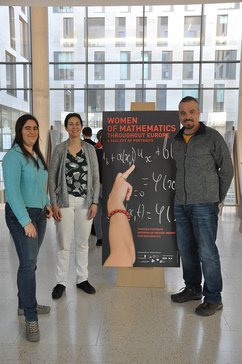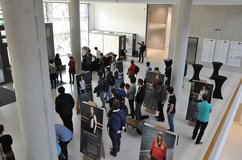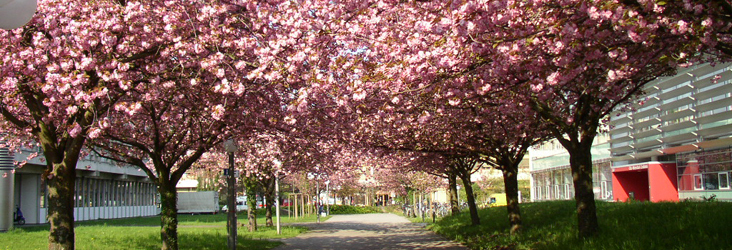
Newsroom
The IWR is an interdisciplinary research center for Scientific Computing which builds bridges across disciplines. It promotes mathematical and computational methods in science, engineering and the humanitites. Currently the IWR comprises more than 50 research teams from various faculties. Around 600 scientists work together in interdisciplinary cooperation projects. In addition to educating the next generation of excellent scientists the IWR also focuses on advacing international research networks.
2019
19. Oktober 2019
Junge Mathe-Talente am IWR
Junior-Starter Seminar für Schüler zur Zahlentheorie
Das Junior-Starter Seminar bietet Schülern der 7. Klasse die Möglichkeit an der Universität ihre mathematische Begabung zu testen und weiterzuentwickeln. Insgesamt 30 Jungen und Mädchen wurden in Projektgruppen zum Thema Zahlentheorie eingeteilt und beschäftigten sich mit Themen wie Teilbarkeiten, Modulo-Rechnung und Primzahlen. Die jungen Mathe-Talente sind von ihrem Gymnasium vorgeschlagen und anschließend vom Team des Landeswettbewerbs Mathematik ausgewählt worden. Zusätzlich zu einem Speed-Wettbewerb, der das erlernte Wissen einüben soll, gibt es am Abschluss der Veranstaltung eine Klausur. Diese ist dann zusammen mit den Ergebnissen beim Landeswettbewerb und bei der Mathematik-Olympiade Entscheidungsgrundlage für die Aufnahme in das Förderprogramm "Jugend trainiert Mathematik", eine schulübergreifende Form der Begabtenförderung.
October 11, 2019
ERC Synergy Grant for Heidelberg Astrophysicist
International research team with Ralf Klessen studies the Milky Way as a “galactic ecosystem”
Astrophysicist Prof. Dr Ralf Klessen, a researcher at the Centre for Astronomy of Heidelberg University (ZAH), is part of an international research team in receipt of an ERC Synergy Grant – a highly endowed grant from the European Research Council (ERC). The funding is awarded to the ECOGAL project, in which researchers from Germany, France, and Italy are collaborating to develop an understanding of the Milky Way as a complex “galactic ecosystem”. Building on the comprehensive observation of various physical scales, the researchers aim at developing a unifying predictive model for the formation of stars and planets in our home galaxy. The project is being funded with approximately 12.7 million euros. The funds will also be used to develop astronomical instruments as well as participate in large-scale projects to systematically survey stars and galactic molecular clouds.
The formation of stars and planets in the Milky Way is governed by the complex interaction of often competing physical influences such as gravity, turbulence, and magnetic fields. In the project “Understanding our Galactic Ecosystem: From the Disk of the Milky Way to the Formation Sites of Stars and Planets” (ECOGAL), the researchers want to observe the underlying scales and processes as a whole rather than in isolation. This represents a paradigm shift in galactic astronomy and astrophysics, as Prof. Klessen emphasises. “A comprehensive model of the Milky Way must consider our galaxy as one large, complex ecosystem in which stars and the related planetary systems can form under very different astrophysical conditions. Similar to Earth, there are different ‘climate zones’ that interact with one another in diverse ways. To better understand these relationships and the related feedback processes is a major thrust of our research project”, explains the Heidelberg astrophysicist.
To develop a unifying model with high predictive power, the researchers intend to identify the key parameters on all underlying physical scales and determine their influence on the formation of stars and planets as well as the dynamic evolution of the Milky Way as a whole. The ECOGAL project is made up of research groups working in the fields of observational astronomy, numerical astrophysics, instrument development, and astroinformatics. The project is being directed by Dr Patrick Hennebelle from the Department for Astrophysics of the French Alternative Energies and Atomic Energy Commission (CEA) in Paris-Saclay. Other members of the research team include Dr Sergio Molinari from the National Institute for Astrophysics (INAF) in Rome and Dr Leonardo Testi from the European Southern Observatory (ESO) headquartered in Garching near Munich. Heidelberg will receive approximately 2.7 million euros of the ERC funding. There, under the direction of Prof Klessen, investigations will be carried out on interstellar turbulence as well as the formation and evolution of galactic molecular clouds. Ralf Klessen heads the “Star Formation and Dynamics of Interstellar Matter” working group at the Institute of Theoretical Astrophysics, which is part of the Centre for Astronomy of Heidelberg University.
ERC Synergy Grants are used to fund forward-looking research projects which, due to their complexity, cannot be tackled by individual scientists and their groups. To this end, the European Research Council provides extensive funding for a period of up to six years.
[Press Release Heidelberg University][Website Prof. Klessen]
September 6, 2019
The accuracy of German citizens’ confidence in their climate change knowledge
Publication in “Nature Climate Change” by IWR Member and HGS MathComp Fellow Nadia Said and her colleagues.
Congratulations to Nadia Said and her colleagues Helen Fischer and Dorothee Amelung on publishing their article “The accuracy of German citizens´ confidence in their climate change knowledge” in “Nature Climate Change” on September 9, 2019. As accurate confidence is related to making appropriate decisions in high uncertainty, the three scientists contribute to a deeper understanding of decision-making in the area of climate change.
August 6, 2019
Video Tutorials available for GigaMesh Software Framework
Dr. Hubert Mara (IWR) and his research group releases a series of video tutorial for the GigaMesh Software Framework on YouTube.
The purpose of this channel is to familiarize users with the varies features of the GigaMesh Software Framework. GigaMesh is developed for processing and analyzing 3D meshes, especially for archaeology-related purposes.
July 23, 2019
Archaeological Exhibition in the Louvre Museum
Dr. Hubert Mara (IWR) contributes visualizations to an archeological Exhibition in the Louvre Museum
From June to December 2019 visualizations with the GigaMesh Software Framework, provided by the IWR, are presented in the Louvre Museum in Paris. These visualizations where done by Dr. Hubert Mara (IWR). They provide a new way to analyze the decorations of archaeological vessels for research in art-history and manufacturing techniques.
The exhibition is dedicated to the Corpus Vasorum Antiquorum (CVA) Project which celebrates its 100th anniversary in 2019. The project was founded after the First World War to foster peaceful cooperation of European Countries through archaeological research. The aim of the project is to create reference catalogues of important ancient ceramics to enable a fast classification of discovered components during excavations.
For further information click on the following links:
[Forensic Computational Geometry Laboratory, Dr. Hubert Mara]
May 23, 2019
Transregional collaborative research centre "Waves to Weather" renewed
Funding has been renewed for a weather forecasting research group that includes members from Ruperto Carola.
The transregional collaborative research centre "Waves to Weather" (CRC/TRR 165) is investigating the limits of predictability in weather forecasting, as well as the scientific fundamentals required for the next generation of forecasting systems. At Heidelberg University, the “Visual Computing” research group, headed by Prof. Dr. Filip Sadlo, is addressing this by researching novel visualisation techniques. Its research is focused on techniques that enable effective analysis of the resulting weather simulations as well as a better understanding of the simulation processes themselves. The Ludwig Maximilian University of Munich is the lead institution for the CRC/TRR 165, which will receive DFG funding in the amount of approximately 13,3 million euros. Further partners in the transregional consortium include the Technical University of Munich, the Karlsruhe Institute of Technology, and the University of Mainz.
April 5, 2019
IWR members Frauke Gräter and Anna Marciniak-Czochra appointed as new fellows of the Marsilius-Kolleg at Heidelberg University
Prof. Gräter and Prof. Marciniak-Czochra will engage in interdisciplinary research projects focusing on “Fake Science” and misconduct in science and research.
Congratulate to Professors Frauke Gräter and Anna Marciniak-Czochra for being appointed as fellows of the Marsilius-Kolleg at Heidelberg University. From April 2019 until March 2020 they will be part of interdisciplinary research projects and contribute to discussions in the Kolleg. The 12th class focuses on “Fake Science” and misconduct in science and research. Furthermore the class will examine the impact of a partnership on individual health from various approaches, including medical, psychological and social factors.
April 5, 2019
Workshop on Spatial and Temporal Analysis of Geographic Phenomena at the IWR
From 1-4 April a compact course and workshop on Spatial and Temporal Analysis of Geographic Phenomena took place at the Interdisciplinary Center for Scientific Computing (IWR). The event was organized by the 3DGeo and FCGL research groups. Participants from a large number of different scientific fields were introduced to topics like processing and analysis of 3D geodata, particularly in the point cloud domain using topographic LiDAR, as well as the usage and visualization of 3D meshes.
The first part of the workshop consisted of lectures, invited talks and hands-on sessions in which the participants learned about processing and analysis of 3D geodata. The sessions were held by researchers of the organizing groups: Dr. Hubert Mara, Dr. Jack G. Williams, Dr. Bartosz Bogacz and Lukas Winiwarter. The second part comprised of a programming and research challenge which required the participants to work on their own tasks in small teams and to present the results at the end of the workshop.
The Event was supported by Heidelberg Graduate School of Mathematical and Computational Methods for the Sciences (HGS MathComp).
February 25, 2019
Exhibition Opening “Women of Mathematics throughout Europe - A Gallery of Portraits"
On February 25 the exhibition "Women of Mathematics throughout Europe - A Gallery of Portraits" was officially opened in Heidelberg. It will be on display from February 26 - May 31, 2019 at the Foyer of the Mathematikon. The opening was organized in close cooperation with the conference "Geometric Analysis meets Geometric Topology“. On behalf of the conference organizers, JProf. Dr. Maria Beatrice Pozzetti, and the Managing Director of the IWR, Dr. Michael J. Winckler, welcomed the guests. The exhibition is kindly supported by the Heidelberg Laureate Forum Foundation (HLFF).
This touring exhibition, whose starting point is the 7th ECM held in July 2016 in Berlin, stems from the observation that nowadays, women still find it difficult to embrace a career in the mathematical academic world and the disparity between the proportion of men and that of women among professional mathematicians is still shamefully large.
The thirteen women mathematicians portrayed here share with us their experience, thus serving as role models to stimulate young women scientists to trust their own strength. In presenting mathematics through women mathematicians’ perspectives and samples of their life stories, we hope to highlight the human aspects of producing mathematics, making this discipline more tangible and therefore more accessible to outsiders or newcomers.
The Exhibition Catalogue is available for 20,00 EUR at the IWR Office (Room 2/303, 2nd Floor, Mathematikon, Opening Hours: Monday-Friday / 09:00-12:00).
18. Januar 2019
Moderne Materialien
16. Modellierungstag Rhein-Neckar findet am 24. Januar statt
Vertreter verschiedener Forschungseinrichtungen sowie Partner aus der Industrie kommen am 24. Januar 2019 an der Universität Heidelberg zum 16. Modellierungstag Rhein-Neckar zusammen. Die Veranstaltung zum Thema „Moderne Materialien“ beschäftigt sich mit aktuellen Entwicklungen in den Materialwissenschaften. In den Vorträgen und Diskussionsrunden werden die rund 50 Teilnehmer aus Wissenschaft und Praxis insbesondere erörtern, welche Rolle die computergestützte Simulationstechnik bei der gezielten Planung von Materialeigenschaften spielt. Organisiert wird die Veranstaltung von der Heidelberger Graduiertenschule der mathematischen und computergestützten Methoden für die Wissenschaften (HGS MathComp) der Ruperto Carola in Zusammenarbeit mit dem Amt für Wirtschaftsförderung und Wissenschaft der Stadt Heidelberg.
„Die Materialwissenschaften zählen zu den Schlüsseltechnologien des 21. Jahrhunderts. Der Einsatz hochmoderner Planungsprozesse sowie bahnbrechende Entdeckungen in der Nanoforschung, in der organischen Elektronik und der computergestützten theoretischen Chemie haben zu einer Revolution in diesem Bereich geführt“, betont Dr. Michael J. Winckler, Geschäftsführer der HGS MathComp. Die Teilnehmer des aktuellen Modellierungstages werden der Frage nachgehen, wie unterschiedliche Forschungsrichtungen zusammenwirken können, um effektive Werkstoffe für höchst unterschiedliche Anwendungsgebiete zu schaffen. Dabei geht es zum Beispiel um die gezielte Kombination von mehreren Eigenschaften, um innovative Materialien zu entwickeln, die gleichzeitig extrem leicht, aber dennoch stabil sind oder die einen effizienten Energietransfer erlauben.
Der 16. Modellierungstag Rhein-Neckar wird in Zusammenarbeit mit der Stadt Heidelberg ausgerichtet. Unterstützt wird der Modellierungstag von der Industrie- und Handelskammer Rhein-Neckar.

